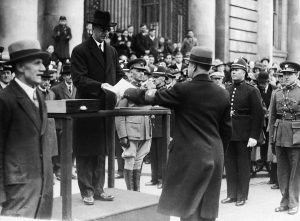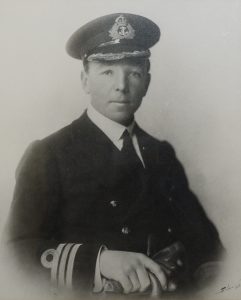BITE-SIZED HISTORY
Published in Issue 4 (July/August 2016), News, Volume 24By Tony Canavan

Above: Éamon de Valera accepting the 1916 Roll of Honour outside the GPO in May 1936. (NMI)
The 1916 Roll of Honour was created on the twentieth anniversary as the official state listing of the men and women who took part in the 1916 Rising. It is comprised of 45 pages with a total of 1,665 signatures of the survivors in 1936, along with the names of 254 of those who had been executed, killed in action or who had died since 1916. Divided according to the garrisons that served around Dublin City during Easter Week, it also includes lists of those who served at Ashbourne and in the garrisons in counties Louth and Meath. The Roll of Honour was presented to Éamon de Valera as part of the twentieth anniversary commemorations and was lodged in the National Museum of Ireland. It is now available on-line as a resource for the public, family members of the participants and researchers athttp://microsites.museum.ie/rollofhonour1916/.
Thirty years of Newry Museum
Happy birthday to Newry and Mourne Museum, which celebrated its thirtieth anniversary in May. The museum originally opened as a wing of the Arts Centre in 1986, after a year’s work converting a Victorian office building for that purpose. Twenty years later it moved to its present location in Bagenal’s Castle, overlooking the city. The castle had been lost for centuries under another building, but when it was discovered it was the obvious location for the new, larger, state-of-the-art museum. I have to admit a personal interest, as in 1985 I was appointed Museum Development Officer (my first job), tasked with establishing the new museum. I remained on as curator until 1990, when I moved on to pastures new.
Awakening the dead
Ireland is not the only country with a troubled past; the ghosts of its civil war continue to haunt Spain. For the first time ever, a Spanish court has authorised the exhumation of the bodies of Republicans from a mass grave in el Valle de los Caídos (the Valley of the Fallen), the last resting place of Francisco Franco. The court in San Lorenzo de Escorial gave permission for the bodies of brothers Manuel and Antonio Ramiro Lapeña Altabás, both killed in 1936, to be retrieved for a ‘dignified burial’. The brothers were killed by Francoist forces and buried in a mass grave in their hometown of Calatayud. In 1959 their remains, along with thousands of others from both sides of the conflict, were re-interred in el Valle de los Caídos, Franco’s monument to the Civil War, where he was later buried. The move has caused controversy, being welcomed by those on the Left but opposed by those on the Right.

Above: County Down’s Barry Bingham—awarded the Victoria Cross for his part in the Battle of Jutland. (North Down Museum)
Remembering Jutland
In late May 1916 the Battle of Jutland,the largest naval battle of the First World War, was fought between the British and German navies. As part of the centenary commemorations, HMS Caroline, a light cruiser that survived the battle and is now berthed in Belfast, opened to the public again on 31 May after a £15m refit. Specialist workers from Ireland, Britain and Poland worked on the ship. The decks were restored, the metalwork refurbished and years of grit removed to make the Caroline shipshape for the grand unveiling. HMS Caroline is the only surviving ship involved in the battle from either navy.
In a related item, the British Woodland Trust, in conjunction with the Royal Naval Association, plans to set aside eight acres of its First World War Centenary Wood in Langley Vale, Surrey, as a memorial to the Battle of Jutland. It will contain a grove named after County Down’s Barry Bingham, who was awarded the Victoria Cross for his part in the battle.
Lost records uncovered
With near-perfect timing, a set of records relating to events of 100 years ago has unexpectedly shown up after being lost for decades. Three ‘Prisoners Books’ of the Dublin Metropolitan Police were found in an attic while renovation work was being done. They were anonymously donated to SIPTU, which in turn handed them over to the Garda Síochána. Lost when the DMP was merged with the Garda, the leather-bound ledgers contain details of 30,000 people arrested between 1913 and 1918, a period which includes dramatic events like the 1913 Lockout and the 1916 Rising. Famous names from James Larkin to Seán Lemass, with details of why they were detained, are all included. This is a treasure trove of information on the DMP during these historic years.
Irish engineering archives
The Industrial Heritage Association of Ireland (IHAI) recently established an Irish Industrial Heritage Archive, which is housed in the Irish Architectural Archive at 45 Merrion Square, Dublin. Further items, including a set of 99 volumes of the Transactions of the Civil Engineers of Ireland(later the Institution of Engineers), have been deposited in the archive. These transactions, first published in 1845, are a valuable resource for research into many aspects of Ireland’s industrial and engineering heritage. For more information, go to the Archives page on the IHAI website, ihai.ie.
















